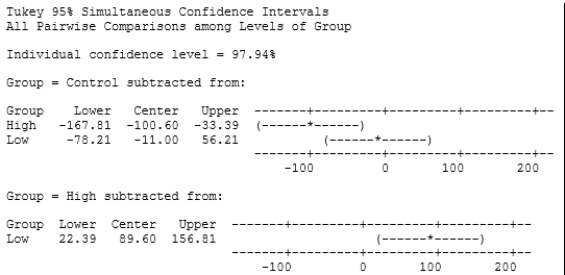Multiple Choice
Instructors gave caffeine to fruit flies to see if it affected their rest. The three treatments were a control, a low caffeine dose of 1 mg/ml of blood, and a higher caffeine dose of 5 mg/ml of blood. Fifteen fruit flies were assigned at random to three treatments, five to each treatment. The minutes of rest measured over a 12-hour period were recorded; the data follow.  Minitab was used to obtain 95% simultaneous confidence intervals for the differences in means among the three treatments using Tukey's procedure; the results follow.
Minitab was used to obtain 95% simultaneous confidence intervals for the differences in means among the three treatments using Tukey's procedure; the results follow.  The average minutes of rest for the five fruit flies assigned to the low-dose group was:
The average minutes of rest for the five fruit flies assigned to the low-dose group was:
A) 11 minutes higher than the average for the five fruit flies assigned to the control dose.
B) 89.6 minutes lower than the average for the five fruit flies assigned to the high dose.
C) 89.6 minutes higher than the average for the five fruit flies assigned to the high dose.
D) 56.21 minutes higher than the average for the five fruit flies assigned to the control dose.
Correct Answer:

Verified
Correct Answer:
Verified
Q4: A marketing researcher was studying the effect
Q5: A population of flights can be classified
Q6: A researcher wished to compare the effect
Q7: A study compared dry matter intake (dmi)
Q8: A population of flights can be classified
Q10: A study compared dry matter intake (dmi)
Q11: Instructors gave caffeine to fruit flies to
Q12: Which test should be used to determine
Q13: A marketing manager studied the effect of
Q14: A population of flights can be classified